Biography
Interests
Nigel Atkinson
Department of Food Chemistry, Teesside University, United Kingdom
*Correspondence to: Mr. Nigel Atkinson, Department of Food Chemistry, Teesside University, United Kingdom.
Copyright © 2018 Mr. Nigel Atkinson This is an open access article distributed under the Creative Commons Attribution License, which permits unrestricted use, distribution, and reproduction in any medium, provided the original work is properly cited.
Abstract
World population is growing, and people are generally becoming more affluent. To deal with these pressures, food production will need to change significantly. Large scale-agriculture and food production with continue to dominate, but the case can be made for local production, not just at town or city level, to scaled down to neighbourhoods and even businesses, other organisations, and even home-based systems. Hydroponics, the growth of plants in soil-less cultures, presents a range of options for such small-scale production.
Abbreviations (if used)
BCE Before current era
CE Current era
CO2eq Carbon dioxide equivalent (CO2eq) stands for a unit based on the global warming potential
(GWP) of different greenhouse gases.
EU European Union
UKP UK pounds
USD US dollars
CD Canadian dollars
Introduction
Hydroponics has the potential to bring significant benefits to food production, not just on large scales,
but right down to individuals. Industrial-scale production systems are becoming commonplace, but small
hydroponic systems and systems integrated into buildings, can bring the hydroponics revolution to everyone.
Some of these systems can be very inexpensive to implement, for example using recycled materials such as
plastic bottles.
It isn’t just about definable environmental benefits, such as reducing carbon footprints, there is a growing body of evidence that having plants around us makes us “feel better”, and may have measurable psychological benefits [1] [2].
There are some fine examples of forward-thinking about how to integrate plants into our home and working environments. For example, the largest urban farm in Japan, which is inside the offices of Pasona, a Tokyobased recruitment agency (LINK) [3].
This is part of a small but growing trend of integrating plants into working and living environments. The Bosco Verticale (Vertical Forest) is a pair of award-winning residential towers in the Porta Nuova district of Milan, Italy designed by Boeri Studio. The two towers host over 2000 plants, including, including 900 trees. (LINK) [4].
Although not specifically hydroponics, Pam Warhurst’s TedTalk on the “Guerrilla Gardening” project in her home town of Todmorden (UK), is another inspirational example of local growing [5] LINK.
This editorial will briefly look at why we need better ways to grow food, the history of hydroponics, and the pros and cons of the technology. Then the focus will shift to the potential of small-scale systems to both improve food production and the environment we live and work in.
Population Pressures
In mid-2017 there was estimated to be nearly 7.6 billion people alive on planet Earth. There are slightly
more males (50.5%) than females (59.5%). Young people under the age of 15 are 26% of the population,
61% are aged between 15 and 59, and 13% are older than 59 [6]. Compared to 1957, by 2017 there are
approximately 2.6 times as many humans alive. From the same baseline by 2057, the multipliers will be 3.5,
and 3.9 by 2097 [7].
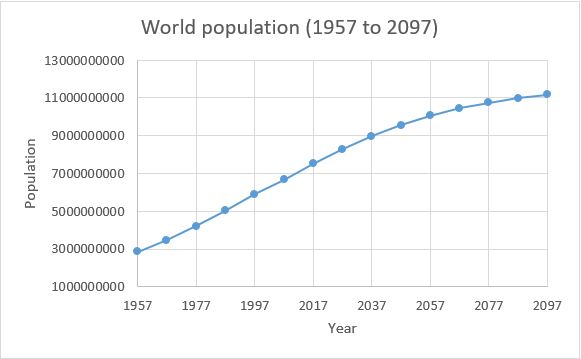
Although population continues to grow (Figure 1), the rate of growth is expected to decline throughout the rest of this century. Nevertheless, the human population will pass 10 billion sometime around the middle of this century, and will reach 11 billion by its end.
“The city is now officially the main habitat of Homo sapiens.” [8]. Half of the human population lives in towns and cities, and it is likely that, by the middle of the century that figure will be close to 70%.
Increasing population and urbanisation will present significant challenges for governments, nongovernmental organisations such as the United Nations, and many businesses. Key issues will be food and nutrition security; these have been defined as shown in table 1 [9].

There is a need to increase food production by 30-40% before 2050 just to meet dietary energy needs [10]. Even if that goal is achieved, it will not necessarily address the nutrition security issue: around 795 million people were undernourished in 2014-16 [9], while more than 2 billion are classified as overweight or obese [11]. “Business” as usual may not address these problems, and as well as developing efficiencies in food production and distribution, new methods and technologies will be essential.
A related issue is the growth of the middles class around the world but especially in regions, such as Africa, India, and Asia. In Africa, the middle class rose from 27% in 1980 to 35% in 2010, entailing a tripling in size from 126 to 350 million, comparable to the middle class in India [12]. The consequences of these changes remain to be seen, for examples there is limited data on whether the food choices of the new middle classes with lean towards highly processed foods, or whether this we see arise value-added local products. In the latter case, local production as discussed here will be important.
Food Miles
Food supply chains around the world may be very long, and have a significant environmental impact. Even in a relatively small country like the UK, food may travel 100s of kilometres “from farm to fork”. In cost terms, the UK spends more than twice as much on food imports as it gains from food exports (39BUKP, and 18BUKP, respectively) [13].
Over 90% of the food for the five major cities in the USA is shipped from outside the city boundaries. Again for America, it has been calculated that food transport is responsible for 0.4 tons of carbon dioxide emissions [14]. Transportation from overseas drastically increases these distances, and concomitant carbon emissions and other negative environmental impacts.
There is more to food transport that just the miles driven, of course. Food needs to be stored safely, often at low temperature. Coley et al., identified the main sources of fossil fuel related carbon emissions for a typical system (Figure 2). This contrasts markedly with the model for local production (Figure 3) [15].
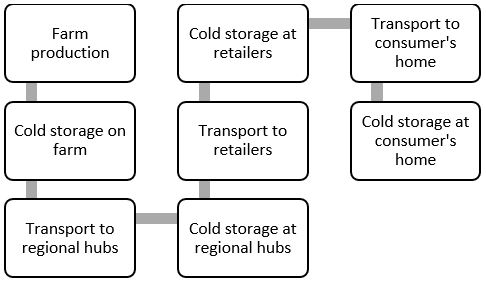
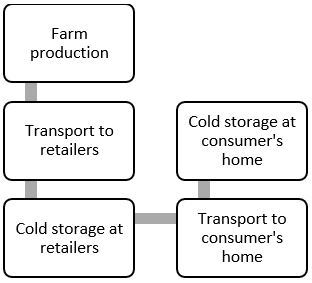
Large-scale Food production will always be needed, of course, and the magnitude of production will need to increase with growing demand. The growing importance of very local food production, that is, on a neighbourhood, business/organisation and home scales, can also be envisaged. These micro-production systems cannot replace large-scale production, but can have an impact, and not just in terms of factors such as carbon emissions.
A Very Brief History of Hydroponics
Hydroponics involves the growth plants in soil-free culture. Although the term was first coined in the
twentieth century, related systems may be traced back to the Hanging Gardens of Babylon (600-500 BCE).
Evidence from pictorial representations of the Babylonian system suggests terraced growing systems with
water supplied by a “chain pump” lift system from the nearly river. Another example may have been the
Aztec floating gardens, called “chinampas”, which were developed as a response of the lack of suitable
land for farming (1300-1400 CE). Many other systems were developed including the off-season growth
of cucumbers (14-35 CE) for the Roman Emperor Tiberius in a structure covered with “transparent rock”
(possibly mica). This is the first known use of a controlled environment for agriculture [16].
The first artificial medium for plant growth was developed by the French chemist Jean Boussingault in 1851. He prepared an artificial soil using sand, quartz and charcoal, with a range of added minerals that had been previously determined to be important for plant growth [17].
In the early 1860s, the German botanists Julius von Sachs and Wilhelm Knop developed the first true hydroponics system. Plant roots were immersed in water containing salts of nitrogen (N), phosphorus (P), potassium (K), magnesium (Mg), sulphur (S) and calcium (Ca). Their work established these elements as the key plant macronutrients and provided the basis for successful hydroponic cultivation. During the next century, other elements essential for plants were identified. These macronutrients including, iron (Fe), chlorine (Cl), manganese (Mn), boron (B), zinc (Zn), copper (Cu) and molybdenum (Mo) [18].
In the 1920s, William Gericke of the University of California developed the first complete hydroponics nutrient solutions. Time Magazine was quick to report this new development:
Last week a new science was given a new name. Hydroponics, by its foremost U. S. practitioner, Dr. William Frederick Gericke of the University of California. Set out in rows at the University’s plant experiment station in Berkeley are a number of shallow tanks made of wood, concrete, and metal. From some of these tanks grow thick, towering clumps of tomato plants bearing rich red clusters of fruit. From other tanks and in an equal state of vigour grow potatoes, tobacco, gladioli, and begonias. The roots of the plants are not in soil but in chemical solutions [19].
From these beginnings, hydroponics has developed in to a significant component of world food production. Given the pressures discussed above, its importance seems likely to grow.
Advantages and Disadvantages of Hydroponic Systems
Although hydroponic systems present many potential advantages, there are some issues that require
attention, especially for large scale systems. Chief among these are start-up costs, and the need for a reliable
electrical supply. Additionally, significant technical and scientific knowledge may be required for industrial
scale systems (table 2).
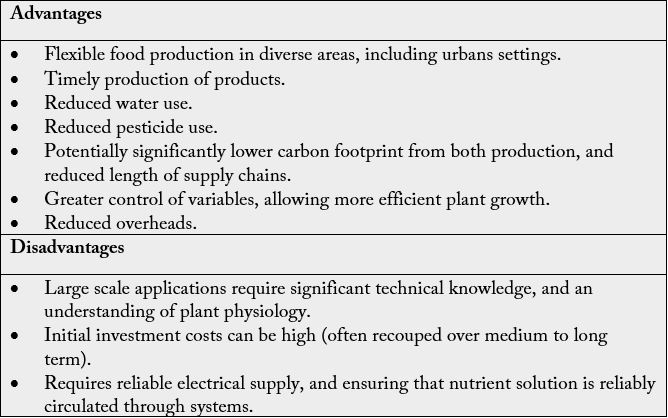
Enhancing Nutrients in Plants
Hydroponics allows accurate control of the nutrients supplied to plants, allowing investigation of the
influence of individual nutrients. Much work has been carried out on general growth characteristics [21]
[22] [23] There is also a growing body of work investigating the impact of nutrient stress on the expression
of key micronutrient such as vitamins. Adding sodium (as NaCl) to the nutrient solution promotes oxidative
stress, which in turn may influence general characteristics such as growth and final yield [24]. Unpublished
work looking specifically on the influence of sodium on ascorbic acid (vitamin C) production in Cochlearia
Offincinalis, a perennial herb noted for its relatively high concentration of ascorbic acid (Figures 4, 5). Results
so far have demonstrated the potential for this approach to enhancing the nutrient profile of food plants
[25].
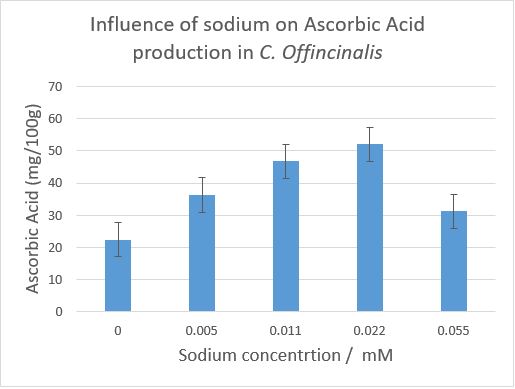
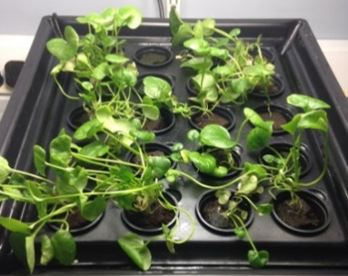
There are many good resources available, both in print and online, describing the different types of hydroponic systems. These range from straightforward summaries [26], to full technical descriptions [27]. Large-scale systems are beyond the scope of the remainder of this article, which will concentrate on small-systems, suitable for workplace, neighbourhood, and home production. Some of these systems are very simple to set up, although all require skills and knowledge to get the best out of them. There are a wide range of instructional videos and other material available. See the links here for example systems.
Developed by B.A. Kratky from the University of Hawaii, this is the simplest hydroponic system. It has no
moving parts, and needs no electricity [28]. Figure 6 shows a tomato plant growing in a recycled plastic
drink bottle. The bottom part of the bottle is normally covered with aluminium foil to prevent the growth
of algae which competes with the plant for nutrients. A standard hydroponic solution is used, and an air
gap is left between the top of the solution to allow oxygenation of the roots. The Kratky method is a very
low-maintenance hydroponic system. Also that is needed when set up is plenty of light and periodic checks
on the nutrient solution level. The Kratky method is best for small, bushy plants like herbs and tomatoes.
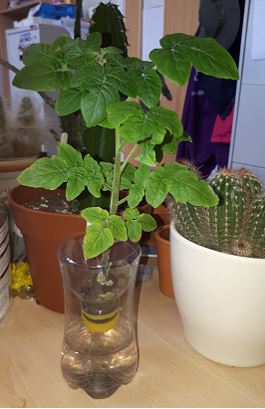
A typical medium sized hydroponics system consisting of propagators, growing tanks, and lights, can cost
around 700UKP (930USD, 1200CD) (figures 7, 8).
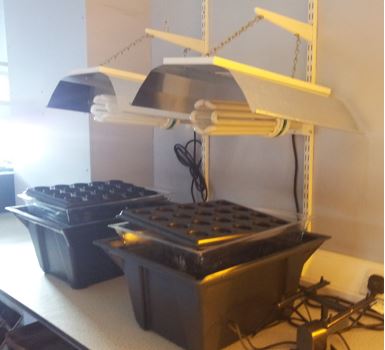
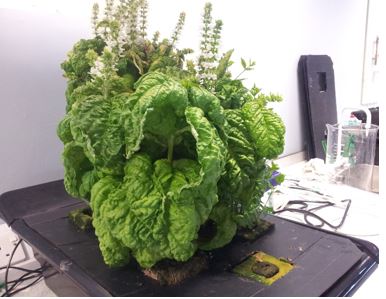
These systems are too large and expensive for use in home or office situations. They are also relatively highmaintenance, requiring close monitoring of issues such as pH and electrical conductivity. With typical poster requirements of around 600 Watts, the lighting systems are potentially expensive in use.
However, there is a goring range of small, easy-to-use, hydroponic systems that are very suitable for home or office use. We use Miracle-Gro AeroGarden systems which cost around 50UKP per unit (65USD, 90CD) (figure 9)
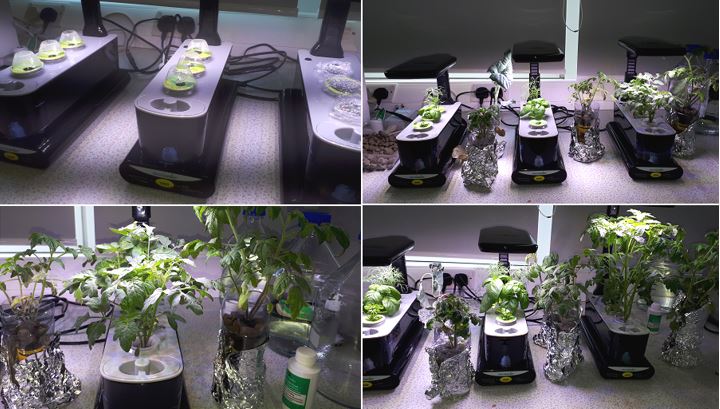
These systems provide basic monitoring of nutrient solution volume and concentration. At 20 Watts the lights have relatively low electrical consumption. They an attractive addition to a room, and are good at growing leafy crops such as herbs. They are, of course much more expensive that do-it-yourself options like Kratky jars.
Aquaponics: Fishy Hydroponics
Aquaponics combines two mature technologies: fish farming (aquaculture) and hydroponics in scalable
systems. It has been described by the UN/FAO as “an integrated approach to efficient and sustainable
intensification of agriculture that meets the needs of water scarcity initiatives” [29]. A wide range of systems
have been developed including those for the growth of carp (Cyprinus carpio) and basil (Ocimum basilicum)
[30], and Lettuce (Lactuca sativa/) and Tilapia (Oreochromis niloticus) [31].
In an aquaponics system, aquaculture and hydroponics are integrated in a recirculatory system: water from the fish tank (A) is pumped (B, C) through plant growth beds (D, E) which act as filters, and back to the fish tank (F) (figure 10). During the cycle, bacteria in the plant growth bed metabolise ammonia, which is toxic fish, into nitrate; an acceptable for of nitrogen for the plants. This symbiotic relationship produces a healthy growing environment for both plants and fish [29].
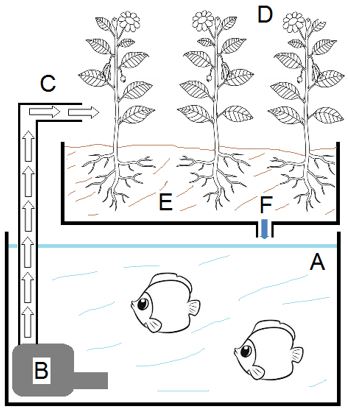
Like most hydroponics-type systems, aquaponics is very scalable, from small-scale to commercial systems. Maucieri and collaborators [32] described a small-scale aquaponics system, built for teaching purposes, using recovered materials including aquarium tanks, and that most problematic of materials, polystyrene.
Currently, commercial-scale applications of aquaponics are few, often due to problems with time-scale for the recovery of initial investment [29]. Successful examples include the Kunia Country Farms operation in Hawaii, USA [33]. This includes 20 aquaponics growth troughs in a one-acre site, using the Tilapia species.
Writing on the Future UK-based proponent of aquaponics Charlie Price has developed an aquaponic solar garden in Monmouthshire, Wales [34] LINK. Fish swim in tanks filtered by salad crops, wastes are fed to soldier flies and worms, which are then used to feed hens. Waste from the birds is recycled back to the flies, to be turned into fish food. As Price notes, this mimics natural environmental processes:
“We are potentially taking a natural system that’s evolved over millions of years and we are just copying it, rather than exploiting it. While it can be seen as complex, it is incredibly simple.”
Window Farms
These are small-scale home hydroponic systems developed using open-source designs developed using a
crowd-sourcing model for innovations. These systems use scavenged, or cheap materials such as used plastic
bottles, and fish tank air pumps (figure 11). As their name suggests, they are meant to be installed on the
inside of domestic or office windows.
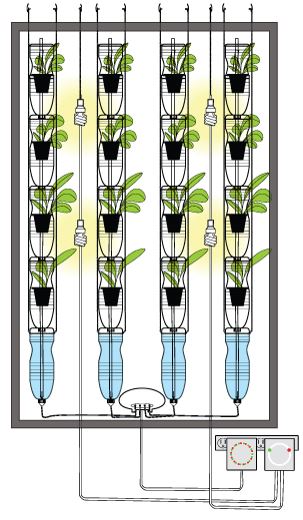
The original social enterprise project was upgraded via a Kickstarter project to a larger scale manufacturing project. However, the company was dissolved in 2016 [35]. Much of the information on window farms was lost in the process, although an effort is being made to collect the data [36]. LINK
The Green Wall
This is a vertical green wall of plants, including flowers and herbs, originally developed by a school in Israel
[37]. LINK.
The project was presented to the community with objectives including: fostering a sense of community, team working, upgrading skills, reusing plastic bottles, and conserving energy (the wall is claimed to have thermal insulating properties). Of the “down-scaled projects discussed here, this is probably the most resource intensive, requiring a drip-irrigation watering system, controlled by a computer system. Recently, another version of the system at Thika’s Joy Town Primary School in Kenya [38]. LINK.
Guerrilla Gardening
This is a community-based model for urban agriculture. Although using traditional growing systems,
“Guerrilla Gardening” projects are allied with the systems described above: they are small-scale, inexpensive
schemes involving the community [39].
People in the small town or Todmorden in West Yorkshire, UK, adopted small sites across the town to grow produce. This scheme was so successful that an international network has developed, with other towns taking on the “Incredible Edible” concept. The mainstreaming of this approach is evidenced by the publication of books on the model, such as Richard Reynold’s “On Guerrilla Gardening” [40], and, of course, some very useful web resources [41] LINK.
Conclusions and Some Caveats
There is often an assumption that local production is more environmentally beneficial that production and
transport from significant distances. This remains an open question, and calculations of environmental
impacts are complex and may produce very different results depending on underlying assumptions [42].
Broadly speaking, air transportation is the most expensive in carbon emissions terms, and transoceanic
shipping the least. [43] [44] (figure 12).
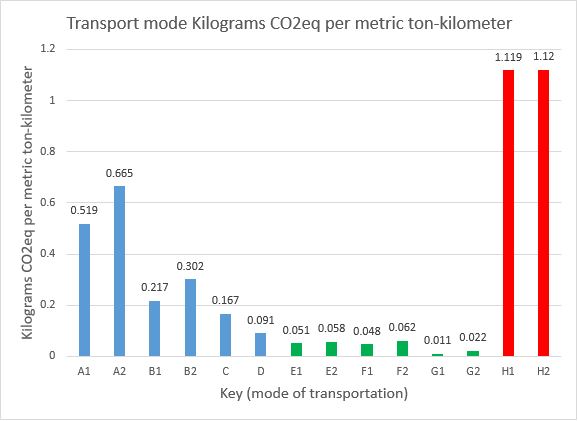
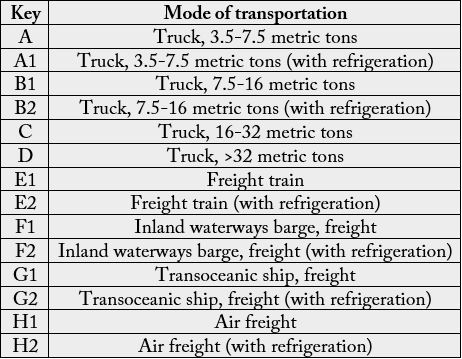
The innovative systems such as those in Tokyo and Milan show the way forward, and although the smallerscaler approaches discussed above surely will have an important role to play, there is clearly a need for the involvement of transnational bodies such as the European Union (EU), and governments and local administrations. The EU project VOLANTE working with expert stakeholders to deliver a vision for sustainable land use across Europe [45] LINK. This advocates optimal use of land resources, living closer to the natural environment, and the self-sufficiency of local communities. These are ambitions that fit well with small-scale local and regional food production, and are another reason to “be inspired”.
Bibliography

Hi!
We're here to answer your questions!
Send us a message via Whatsapp, and we'll reply the moment we're available!